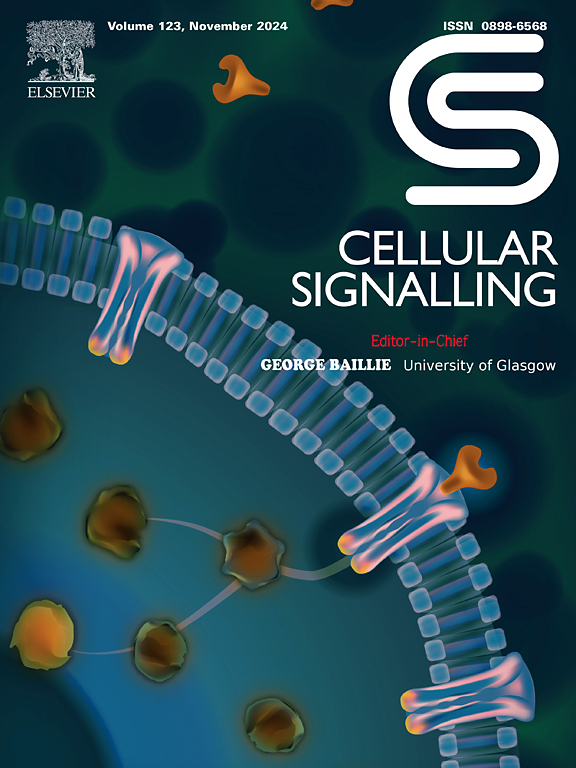Tau deficiency contributes to impaired bone formation via activating PPARγ signaling
IF 4.4
2区 生物学
Q2 CELL BIOLOGY
引用次数: 0
Abstract
Tau protein is enriched in neuronal axons, it functions as a stabilizer of axonal transportation. Hyperphosphorylation of Tau in the brain results in early-onset Alzheimer's disease (AD), causes remarkable bone loss. Notably, pathological Tau leads to the loss of specific physiological Tau that exaggerates Tau toxicity. However, little was known about the physiological role of Tau in bone homeostasis although it's rarely expressed in peripheral tissues. Here, we provided evidence for brain Tau's role in promoting bone formation. Tau knockout (Tau−/−) mice showed smaller body size and exhibited osteoporotic-like deficit, including reduced trabecular and cortical bone mass, especially in young male Tau−/− mice. Such a deficit is likely due to a decrease in osteoblast (OB)-mediated bone formation, as little change in bone resorption in Tau−/− mice. Further mechanistic studies showed increased PPARγ signaling in the brain of Tau−/− mice, which contributed to chemerin release and CMKLR1upregulation in Tau−/− mice brain. Chemerin neutralization remarkably restored osteogenesis potential. Furthermore, reduced repressive H3K9me2 in Tau−/− mice brain led to decreased enrichment of H3K9me2 at PPARγ promoter and thus increased chemerin production. Moreover, PPARγ inhibitor GW9662 significantly reversed the osteoporotic phenotype of Tau−/− mice. Our results implicated brain Tau acting as a dominant positive regulator in bone mass, and unveiled a potential clinical value of PPARγ inhibition in treatment of AD-associated osteoporotic deficits.
Tau缺乏通过激活PPARγ信号导致骨形成受损。
Tau蛋白富集于神经元轴突,是轴突运输的稳定剂。大脑中Tau蛋白的过度磷酸化导致早发性阿尔茨海默病(AD),导致显著的骨质流失。值得注意的是,病理性Tau蛋白会导致特定生理性Tau蛋白的丢失,从而加剧Tau蛋白的毒性。然而,尽管Tau蛋白很少在外周组织中表达,但对其在骨稳态中的生理作用知之甚少。在这里,我们提供了脑Tau蛋白在促进骨形成中的作用的证据。Tau敲除(Tau-/-)小鼠表现出较小的体型和骨质疏松样缺陷,包括小梁和皮质骨量减少,特别是在年轻雄性Tau-/-小鼠中。这种缺陷可能是由于成骨细胞(OB)介导的骨形成减少,因为Tau-/-小鼠的骨吸收几乎没有变化。进一步的机制研究表明,Tau-/-小鼠大脑中PPARγ信号的增加,有助于Tau-/-小鼠大脑中趋化素的释放和cmklr1的上调。趋化素中和可显著恢复成骨潜能。此外,Tau-/-小鼠大脑中抑制性H3K9me2的减少导致PPARγ启动子处H3K9me2的富集减少,从而增加趋化素的产生。此外,PPARγ抑制剂GW9662显著逆转Tau-/-小鼠的骨质疏松表型。我们的研究结果表明,脑Tau在骨量中起着主要的正调节作用,并揭示了PPARγ抑制在治疗ad相关骨质疏松症中的潜在临床价值。
本文章由计算机程序翻译,如有差异,请以英文原文为准。
求助全文
约1分钟内获得全文
求助全文
来源期刊

Cellular signalling
生物-细胞生物学
CiteScore
8.40
自引率
0.00%
发文量
250
审稿时长
27 days
期刊介绍:
Cellular Signalling publishes original research describing fundamental and clinical findings on the mechanisms, actions and structural components of cellular signalling systems in vitro and in vivo.
Cellular Signalling aims at full length research papers defining signalling systems ranging from microorganisms to cells, tissues and higher organisms.
 求助内容:
求助内容: 应助结果提醒方式:
应助结果提醒方式:


